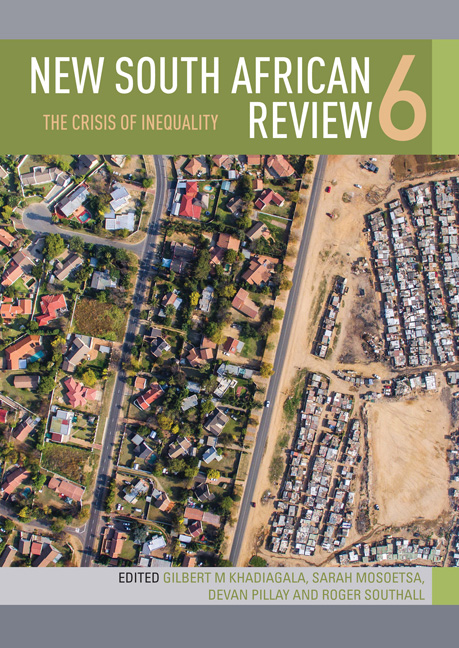Book contents
- Frontmatter
- Contents
- List of tables and figures
- INTRODUCTION: The global crisis of inequality and its South African manifestations
- PART 1 INEQUALITY AND CLASS: POLARITIES AND POLICIES
- PART 2 THE POLITICS OF INEQUALITY
- PART 3 SOCIAL DIMENSIONS OF INEQUALITY
- PART 4 LAND AND ENVIRONMENT
- CHAPTER 12 Spatial defragmentation in rural South Africa: A prognosis of agrarian reforms
- CHAPTER 13 Mining, rural struggles and inequality on the platinum belt
- CHAPTER 14 Challenging environmental injustice and inequality in contemporary South Africa
- CHAPTER 15 The geography of nuclear power, class and inequality
- Contributors
- Index
CHAPTER 15 - The geography of nuclear power, class and inequality
from PART 4 - LAND AND ENVIRONMENT
Published online by Cambridge University Press: 23 March 2018
- Frontmatter
- Contents
- List of tables and figures
- INTRODUCTION: The global crisis of inequality and its South African manifestations
- PART 1 INEQUALITY AND CLASS: POLARITIES AND POLICIES
- PART 2 THE POLITICS OF INEQUALITY
- PART 3 SOCIAL DIMENSIONS OF INEQUALITY
- PART 4 LAND AND ENVIRONMENT
- CHAPTER 12 Spatial defragmentation in rural South Africa: A prognosis of agrarian reforms
- CHAPTER 13 Mining, rural struggles and inequality on the platinum belt
- CHAPTER 14 Challenging environmental injustice and inequality in contemporary South Africa
- CHAPTER 15 The geography of nuclear power, class and inequality
- Contributors
- Index
Summary
Democratic South Africa still grapples with one of the artefacts of apartheid – an apartheid geography that continues to be a spatial manifestation of race, class and inequality. This is particularly evident in the country's nuclear geographies where nuclear colonialism (a system whereby government and business target communities directly or indirectly to maintain the nuclear process) has been perpetuated by the democratic government since 1994 (Endres 2009: 39). The South African government, despite the ruling party's historically fierce opposition to nuclear energy (EMG and Western Cape ANC 1994), intends to perpetuate these geographies as well as to add new nuclear geographies such as at Bantamsklip and Thuyspunt.
Scant attention has been paid to the socio-economic impact on the local host communities in close proximity to these nuclear facilities (DEPP 2009). This atomic amnesia corresponds to the neglect, in the past, by scholars, the nuclear industry and the government to the communities close to a nuclear installation or a uranium mine. Typically, these communities are predominantly black as the legislation at the time of their construction prohibited nuclear installations within fifty kilometres of white communities. For the purpose of this chapter, three nuclear facilities – the Koeberg Nuclear Power Station (hereafter Koeberg) in the Western Cape; the facilities of the Nuclear Energy Corporation of South Africa (Necsa) (hereafter Pelindaba) at Pelindaba; and the National Radioactive Waste Disposal Facility (hereafter Vaalputs) at Vaalputs in the Northern Cape – illustrative of the country's nuclear geography, were selected for analytical purposes (see Figure 15.1 and Table 15.1). Each of the sites represents a specific aspect of the nuclear fuel cycle or nuclear energy complex in the country (see Table 15.1).
All of these facilities are part of South Africa's pre-1994 nuclear energy and weapons legacy. More pertinent to this study, these facilities represent instances of South Africa's nuclear geography. Other examples of this include, for example, the Vastrap Test Site in the Kalahari Desert (Von Wielligh and Von Wielligh-Steyn 2014); St Lucia where South Africa tested ballistic missiles in the early 1990s; Johannesburg and its surrounding areas as uranium naturally occurs with gold deposits here and has been reported to be an element in the city; and the Gauteng province's growing radioactive and acid mine water drainage problem.
- Type
- Chapter
- Information
- New South African Review 6The Crisis of Inequality, pp. 268 - 284Publisher: Wits University PressPrint publication year: 2018



